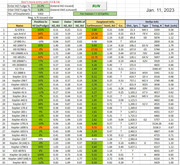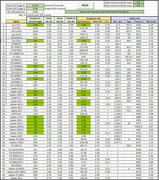In another thread, Pale blue dot thread, the catalog presented from another paper, here, presents an extensive list of exoplanets in the HZs (both OHZ and CHZ). The OHZ is the Optimistic zone that extends to an Early Venus position to allow consideration of exoplanets that may have once had liquid water, I think. It also extends to a Mars for the outer OHZ.
This broadens the HZ, of course, so more exoplanets will be found.
One area I would like explanation is that the list is based on extensive formulations done in 2014 where the Early Venus and the Mars parameters were limited to a mass of 1 Earth. The coefficients vary as mass changes, and the list includes very massive objects that would seem to me, at least, not be ones that could be used for those limited formulations.
With that in mind, I elected to simply adjust (fudge) the inner and outer zones a little but limit the exoplanet mass to under 13 Earth masses. As noted in a prior post, I also tweaked their 2017 Radius => Mass equation to fit today's better data. This is important since their HZ formulae require both radius and mass. I could extend the list to the more Jupiter-like exoplanets, as they did, but I don't have reliable coefficients, nor do I think there is great hope for an Earth-like Jupiter-mass exoplanets to be found, for that matter.]
Notice that their method produces only 4 HZ exoplanets with reasonable masses.
View: https://imgur.com/LUhhw7C
This broadens the HZ, of course, so more exoplanets will be found.
One area I would like explanation is that the list is based on extensive formulations done in 2014 where the Early Venus and the Mars parameters were limited to a mass of 1 Earth. The coefficients vary as mass changes, and the list includes very massive objects that would seem to me, at least, not be ones that could be used for those limited formulations.
With that in mind, I elected to simply adjust (fudge) the inner and outer zones a little but limit the exoplanet mass to under 13 Earth masses. As noted in a prior post, I also tweaked their 2017 Radius => Mass equation to fit today's better data. This is important since their HZ formulae require both radius and mass. I could extend the list to the more Jupiter-like exoplanets, as they did, but I don't have reliable coefficients, nor do I think there is great hope for an Earth-like Jupiter-mass exoplanets to be found, for that matter.]
Notice that their method produces only 4 HZ exoplanets with reasonable masses.
View: https://imgur.com/LUhhw7C
Last edited:






